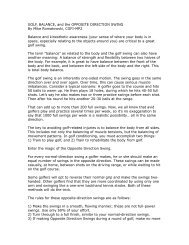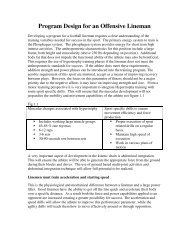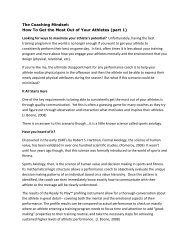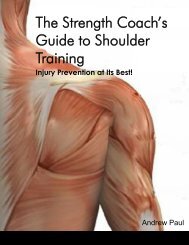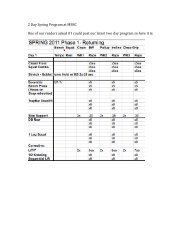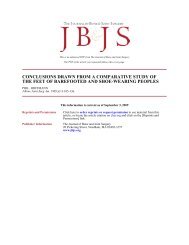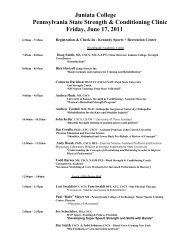Sprint Interval Training - “It's a HIIT - Strength Coach.com
Sprint Interval Training - “It's a HIIT - Strength Coach.com
Sprint Interval Training - “It's a HIIT - Strength Coach.com
You also want an ePaper? Increase the reach of your titles
YUMPU automatically turns print PDFs into web optimized ePapers that Google loves.
Ultimately, the training affect on the cardiovascular system and oxidative metabolism from LMICT led to it<br />
being labeled “cardio” or “aerobic” exercise and to the thought process that this type of training, and only this type<br />
of training, would positively condition the cardiovascular system. This same process and resultant thinking played<br />
out with the research examining fat metabolism and “burning” fat stores. It eventually lead to the early American<br />
College of Sports Medicine guidelines that spread the doctrine of engaging in rhythmical “aerobic” activities three<br />
to five times per week, for 20 to 60 minutes at an intensity of 60‐90% of maximal heart rate reserve or 50‐85% of<br />
maximal aerobic capacity 7 . As already noted, the re<strong>com</strong>mended duration of exercise was heavily influenced by the<br />
metabolic equipment of that time, which, in turn, dictated the exercise intensity; anyone exercising at 60‐90% of<br />
their maximal heart rate reserve will, by physiological default, last about 20 to 60 minutes. Further, I do not think<br />
it is a coincidence that the re<strong>com</strong>mended frequency of exercise paralleled the timetable of academic classes of the<br />
students who invariably became subjects for the research that influenced these very re<strong>com</strong>mendations!<br />
While I do not dispute the positive effects reported in the research from LMICT, it is now clear from recent<br />
research that, when one factors in the overall health and performance benefits, as well as the investment of time,<br />
<strong>HIIT</strong> trumps LMICT every time. <strong>HIIT</strong> produces a whole host of health benefits, including cardiovascular health and<br />
fat loss, which are the most <strong>com</strong>mon reasons people engage in an exercise program in the first place. Whenever<br />
researchers have <strong>com</strong>pared these two types of training regimes, side by side, the <strong>HIIT</strong> has always matched LMICT,<br />
and usually produced more favorable results, with a much lower investment of time. So, clearly, this message is<br />
extremely important given that the time <strong>com</strong>mitment is invariably given as the main excuse for not starting or<br />
sticking with an exercise program. Well, effective <strong>HIIT</strong> programs for improving cardiovascular endurance and body<br />
<strong>com</strong>position require significantly less time than traditional “cardio” programs. So, with some simple education, we<br />
can immediately eradicate the main excuse for not exercising – I think that is a good reason to make sure that<br />
everyone is not ignorant to the research. The somewhat surprised look on the faces of the health care<br />
professionals attending the seminars I speak at transcends the depth of indoctrination the early research has<br />
created. The reason I say this is because if one simply stands back from science and looks at this from a <strong>com</strong>mon<br />
sense perspective, it is far more logical that <strong>HIIT</strong> would be more effective than LMICT.<br />
5



